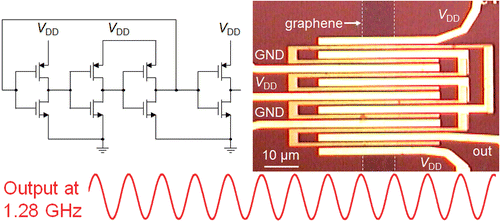June 18, 2013 report
Team builds first integrated graphene digital circuit to function at gigahertz frequencies

(Phys.org) —A research team with members from the U.S. and Italy has succeeded in building an integrated graphene digital circuit that is able to function at gigahertz frequencies. In their paper published in the journal ACS Nano, the team describes how they built their circuit, its performance, and its limitations.
Researchers around the world continue to look to graphene as a means to overcome the size limitations of silicon—making circuits smaller than 10nm. Graphene is an ideal candidate because electrons can pass through the single layer of carbon atoms as if they had no mass. Unfortunately, graphene is not a semiconductor, thus other materials have to be included in a device to allow graphene to be used in a circuit. To date, efforts to do so have met with limited success—current leaks at the juncture points leading to poor performance.
In this new effort, the researchers built a ring oscillator—a circuit used to evaluate the performance limits of digital electronic devices—based on graphene using a new technique (prior attempts by other teams to build such a device exhibited limited performance). To create a stronger connection between the graphene and other components, the team grew the graphene directly on them. Once all the pieces were in place, the team tested the device by applying electricity, slowly lowering the voltage. As they did so, the oscillation frequency increased—moving from 350MHz to 1.2GHz. Such a frequency is routine for silicon based devices but marks a new high point for those based on graphene.
In running their circuit, the researchers noted one feature of their device that was actually better than those based on silicon—performance wasn't degraded due to fluctuations in voltage. They also acknowledge that like other devices based on graphene, there was still too much current leakage and its speed was limited by resistance at the graphene and its substrate boundary. This means their graphene-based ring oscillator is not yet ready for the real world. Still, they believe their work has shown that graphene-based high frequency circuits can be made and that further work may reduce the resistance and lead to higher frequency graphene based circuits.
More information: Gigahertz Integrated Graphene Ring Oscillators, ACS Nano, Article ASAP. DOI: 10.1021/nn401933v
Abstract
Ring oscillators (ROs) are the most important class of circuits used to evaluate the performance limits of any digital technology. However, ROs based on low-dimensional nanomaterials (e.g., 1-D nanotubes, nanowires, 2-D MoS2) have so far exhibited limited performance due to low current drive or large parasitics. Here we demonstrate integrated ROs fabricated from wafer-scale graphene grown by chemical vapor deposition. The highest oscillation frequency was 1.28 GHz, while the largest output voltage swing was 0.57 V. Both values remain limited by parasitic capacitances in the circuit rather than intrinsic properties of the graphene transistor components, suggesting further improvements are possible. The fabricated ROs are the fastest realized in any low-dimensional nanomaterial to date and also the least sensitive to fluctuations in the supply voltage. They represent the first integrated graphene oscillators of any kind and can also be used in a wide range of applications in analog electronics. As a demonstration, we also realized the first stand-alone graphene mixers that do not require external oscillators for frequency conversion. The first gigahertz multitransistor graphene integrated circuits demonstrated here pave the way for application of graphene in high-speed digital and analog circuits in which high operating speed could be traded off against power consumption.
Journal information: ACS Nano
© 2013 Phys.org





















